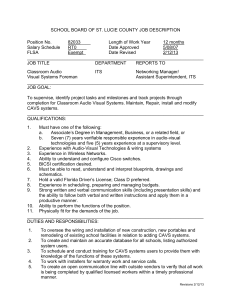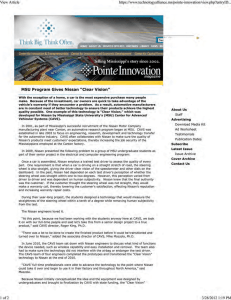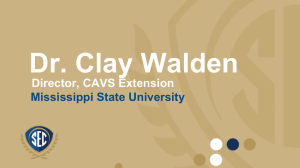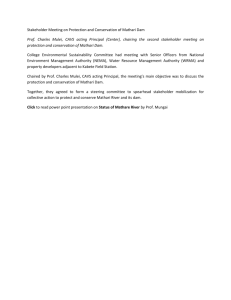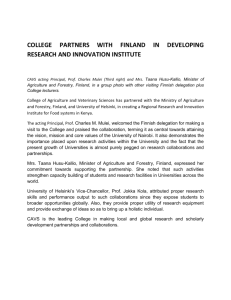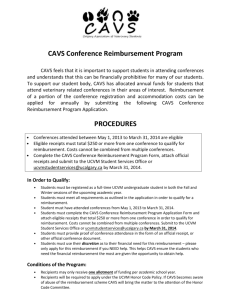Document 14572927
advertisement
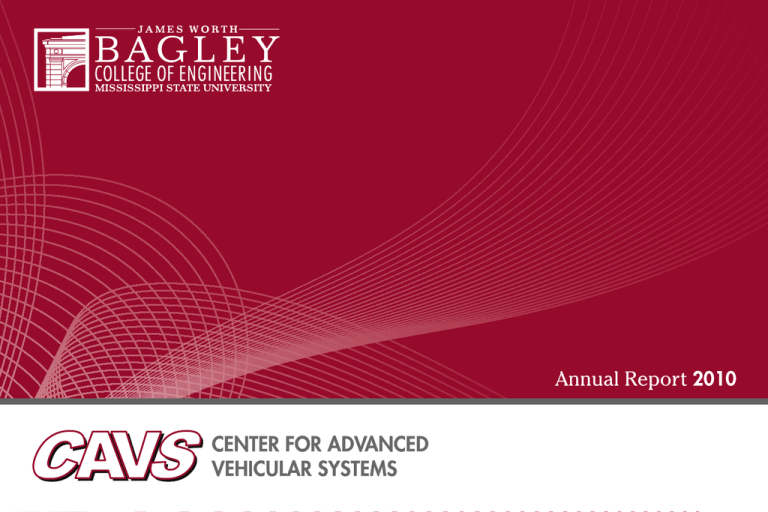
Director’s message..........................................................................................2 Researchers flex scientific muscle to improve athlete performance......................4 Multiscale modeling keeps tanks on track.........................................................6 CAVS won’t stand idle on pollution problem.....................................................8 Vehicle materials research fuels new models for nuclear reactors.....................10 Uniting the state’s talent and resources so that we can all breathe a little easier.....12 CAVS offers international industry services and solutions...................................14 Recognitions............................................................................................16 Research awards............................................................................................17 Research highlights.........................................................................................18 Writers: Diane Godwin, Susan Lassetter Editor: Heather Wainwright Designer: Heather Rowe Photographer: Megan Bean Contributors: Greg Burgreen, Youssef Hammi, Roger King, Esteban Marin, Masoud Rais-Rohani, Hongjoo Rhee, Kiran Solanki, Mark Tschopp, David Thompson Director’s Message The Center for Advanced Vehicular Systems (CAVS) at Mississippi State University (MSU) is an interdisciplinary research center with a strong commitment to computational science and engineering. Our threefold mission is • • • to increase the nation’s knowledge base through our research; to support economic development in the state of Mississippi through our engagement activities; to advance the university’s national recognition in higher education through our academic activities. A longtime keystone of the Bagley College of Engineering (BCoE), our collaborative research activities incorporate materials science, manufacturing process modeling, computational mechanics, computational fluid dynamics, multi-scale modeling, vehicular systems engineering, design optimization, human factors and ergonomics, alternative-powered systems, and intelligent electronic systems. Research activities include efforts in vehicle weight reduction, structural integrity, hybrid power train design, energetics, advances in design and predictability as well as improved diagnostics, manufacturing, training systems, and computational design technologies. While CAVS’ projects generate timely solutions relevant to regional manufacturers, CAVS’ research 2 seeks to expand knowledge that is essential for sustained economic development in Mississippi and nationwide. Furthermore, through direct involvement in these various activities at CAVS, students leverage their classroom instruction with indispensable, practical experience. This year we made significant strides in accomplishing the Center’s goals. Please review the Research Highlights for a synopsis of activities and events that have propelled CAVS and MSU into regional, national, and international prominence. For an even more in-depth review of six particular projects ongoing at CAVS, please read our Research Spotlights section. Finally, we proudly present in Recognitions some of the accomplishments of our talented faculty, staff and students to underscore that our success begins with our people. BEGINNINGS...AND BEYOND CAVS serves as BCoE’s nexus for high performance computing activities. This strength was first recognized in 1990 when the National Science Foundation awarded the college an Engineering Research Center focused on Computational Field Simulations. CAVS now marries that previous work in computational fluid dynamics with computational structural mechanics and manufacturing to support the diverse needs of industry in the state of Mississippi. CAVS Annual Research Report Today, with a staff of nearly 235 faculty, research staff, postdocs, and students, CAVS’ research and extension enterprise is well-situated to support the long-term needs of Mississippi industry. We strive to be the primary Southeastern US academic resource for solutions and innovations in complex interdisciplinary fields, particularly those related to automotive, aerospace and transportation industries. our research teams include 65 undergraduate students from 22 undergraduate majors and 71 graduate students from 16 different graduate degree programs. All of these students’ practical, advanced experience at CAVS garners for them a variety of vital skills, from project management to end-user collaboration. EDUCATION IS THE CORNERSTONE CAVS represents a commitment by the State of Mississippi to work with and support Mississippi industry through project-based activities. The management at CAVS, as well as our research teams in general, recognizes the need to generate economic development via technological and scientific discovery. Therefore, CAVS serves as a knowledge resource for existing and future Mississippi industries. Key to CAVS’ mission, then, is providing engineering support to the state’s automotive industry and other manufacturers to enhance their competitiveness in the global market. CAVS directly engages with these manufacturers and other key stakeholders (e.g., state agencies and industrial associations) to introduce and apply best practices and technologies through both onsite projects and workshops. Additionally, more strategic engagements address the broader needs of economic development throughout the state. There is an increased demand in industry, academia, and government for scientists and engineers with expertise utilizing simulation tools to create new technologies and improve upon existing ones. In fact, the area of computational engineering and science has quickly emerged with cross-disciplinary connections to engineering, mathematics, computer science as well as other sciences, and much of CAVS’ research and student thesis and dissertation work features a strong computational component. CAVS also collaborates with BCoE as the academic department for the graduate program in Computational Engineering. Provided wide-ranging curricula, our graduates matriculate having mastered not only the basic approaches to solving analytical problems, but also the use of mathematical and computational tools required to arrive at real-world solutions. Further indicative of our dedication to interdisciplinary synergy, www.cavs.msstate.edu ECONOMIC DEVELOPMENT: MISSISSIPPI’S FUTURE FORTHCOMING As we lead into 2011, CAVS looks forward to maintaining our dynamic relationships with federal and state agencies, national and regional corporations, and campus-wide departments and centers. As we sustain our quest for greater excellence, we will maximize utilization of resources such as our state-of-the-art facility and our exceptional-caliber faculty, research staff, and students. We will continue efforts to expand our portfolio of short-and longterm research initiatives. Finally, with this report, we illustrate the emerging fruition of our vision to integrate superior education and research with relevant solutions and innovations for automotive, aerospace, transportation and other industries in the State of Mississippi and the Southeast. Best regards, Roger L. King, Ph.D. Director, CAVS 3 Researchers flex scientific muscle to improve athlete performance When MSU football players take the field, they must be prepared for 60 minutes of some of the most intense competition in NCAA sports. As part of the Southeastern Conference, they have to hit harder, run faster and generally push their bodies to the absolute edge of human ability just to remain competitive and uninjured. To help these athletes reach that elite level of play, the MSU Athletic Department is partnering with CAVS for a new Sports Performance Program. Combining engineering know-how with established training methods, the program adds a new layer to coaches’ understanding of their players’ physiologies. “The data we collect supplements the information that the trainers routinely gather and will help them evaluate their current training programs or put in place new programs,” CAVS assistant research professor Daniel Carruth explained. Working with Matt Balis, head strength and conditioning coach; Allen Thompson, assistant athletic trainer; Adam Knight, assistant professor of sports biomechanics, and other scientists 4 from the university’s kinesiology department, the CAVS researchers are using motion capture technology and specialty modeling software to allow the coaches to monitor, from any angle, how an athlete moves and reacts when performing certain actions. entering the program. “Currently the coaches use video to help evaluate players’ physical performance while in training, but this only allows them to see one side at a time. We are able to provide 3-D images which let the coaches evaluate the player as a whole,” Carruth said. Carruth added, “By assessing the current state of an athlete, we are able to give the coaches valuable information to help them individualize their training program to meet a player’s needs.” Knight added, “We can also use this data to identify potential problem areas and possibly prevent some injuries. We can’t prevent everything, but being able to tell if an athlete is predisposed to certain problems allows for more targeted training.” The program began this summer when the researchers collected data on a select group of athletes. After establishing what data would best allow the coaches to assess the players’ physical performance, the group began collecting information to serve as a baseline for players “Corrective exercise is cutting edge, and I believe the future of strength and conditioning is to individualize training programs to target weak areas,” Balis said. Carruth believes that the potential applications of their data collection methods could be expanded to include all Bulldog athletic teams and even area rehabilitation or physical therapy units. For more information about Performance Program, contact dwc2@cavs.msstate.edu or visit factors and ergonomics research page, www.cavs.msstate.edu/hse. the Sports Carruth at the human team’s Web CAVS Annual Research Report www.cavs.msstate.edu 5 6 CAVS Annual Research Report Multiscale modeling keeps tanks on track Roadside assistance service doesn’t extend to the front line. When a 68-ton tank experiences mechanical failure, not only does a serious safety concern arise, but the warfighters’ ability to complete the mission is inhibited. Consequently, the parts that comprise these machines must be built to last, even in extreme conditions. The development of these materials can be expensive and time consuming. To combat these costs, the U.S. Army has enlisted the help of Drs. Esteban Marin, Jean-Luc Bouvard, and Mark Horstemeyer to use CAVS’ multiscale modeling capabilities to create models that predict the behavior of rubber material used in military vehicles. The project is part of the Army’s five-year, $75 million academic and industry research partnership, Simulation Based Reliability and Safety (SimBRS), led by CAVS. Primarily, the research team is working to model the polymers used to make road wheel backer pads for M1 Abrams tanks. These pads www.cavs.msstate.edu are rubber components placed between the interior of a tank’s track and its wheels. When one fails, the tank is out of service until the track can be repaired. Statistics show that the current pads fail too frequently due to the rubber’s shortened lifespan in its present active service conditions. The military would like to develop a new material to replace the existing polymer altogether. To do so without modeling would be prohibitively expensive and prolonged. “Right now, to test a new design, they have to build and install it, then take it out to a testing location, collect results, tweak the design, and start the process over again,” explained Hayley Brown, a mechanical engineering doctoral student working on the team. Bouvard added, “In the future, they will be able to use our model to simulate the behavior of a new polymer to decide if it should be built and tested. It will save a lot of time and money.” He explained that through multiscale modeling, the team is working to understand the polymer’s microstructure effect on mechanical behavior and material failure. By understanding how variables like heat, pressure and environmental factors affect the mechanical properties of the polymer, the researchers can estimate the lifespan of the material. “At the end, we would like to provide numerical tools that accurately predict the behavior of any polymer,” Bouvard said. Brown added, “Once we are able to model track rubber, the tools can be adapted for any type of elastomer and will have many commercial applications.” For more information about the polymer research, contact Bouvard at jeanluc@cavs. msstate.edu or visit the computational manufacturing and design Web page, www. cavs.msstate.edu/cmd. 7 CAVS won’t stand idle on pollution problem When shoppers stop at the supermarket to purchase fresh produce, they seldom think about how those items make it to their local grocery shelves—until they step outside. There, they will likely encounter a parked semi-truck with its engine running, diesel emissions emanating from its exhaust pipes. “Most people can’t imagine just sitting in their vehicles with the engine running, burning fuel and putting off emissions, but that’s what semitrucks do all over the country, all of the time,” explained electrical and computer engineering professor Mike Mazzola. “The reason those engines are left idling is because the drivers are living in their trucks. And just like everyone else, they want air conditioning in the summer and heat in the winter.” While necessary for driver comfort, this practice can be costly, both in fuel consumption and its effects on the environment. Unlike when the truck is on the road, exhaust from an idling engine becomes concentrated around the vehicle, creating environmental and health hazards in the surrounding area. 8 To help mitigate this problem, the Southeastern region of the Environmental Protection Agency awarded CAVS a $1.08 million grant, allowing university researchers to partner with Mississippi-based KLLM Transport Services and Dufour Petroleum Inc. to install and evaluate the usefulness of new idle reduction technology in 18-wheelers. “We are facilitating the installation of batterypowered air conditioning units on more than a hundred trucks in these two fleets,” said Angela Card, an electrical engineer on the research staff. “When the truck is stopped, the driver will be able to turn the engine off but still have air conditioning or heat. This eliminates the need to idle the engine, which will reduce fuel consumption and emissions.” reduce carbon dioxide emissions by 1,604 tons. “The benefits of this type of technology are becoming quite clear, but its cost is not insignificant,” Mazzola explained. “We have to get solid information and operational experience to show that the benefits outweigh the cost, and that’s what this project will allow us to do.” The researchers expect to have all of the air conditioning units installed within 18 months and will complete their data collection by 2012. Theirs was one of only five projects, out of more than 40 applications submitted to the EPA’s Southeast region, to receive funding. For more information, contact Mazzola at mazzola@cavs.msstate.edu. Once drivers are on the road again, they will be able to switch back to the standard air conditioner while the engine charges the battery-powered unit for the next use. Preliminary estimates indicate that the technology will annually save the companies more than 140,000 gallons of diesel fuel and CAVS Annual Research Report www.cavs.msstate.edu Photo courtesy of KLLM Transport Services 9 10 CAVS Annual Research Report Photo courtesy of Entergy Mississippi Vehicle Materials Research Fuels New Models for Nuclear Reactors The mere mention of the word “nuclear” creates a negative connotation in some political and social circles, and it becomes even more controversial when the subject of nuclear energy arises. However, cutting-edge research at CAVS may help alter misconceptions to change contentious views of nuclear energy into indisputable support. Dr. Mark Horstemeyer, the CAVS Chair in solid mechanics, and his research team have earned competitive grants from the U.S. Department of Energy and will be working closely with Pacific Northwest National Laboratory, Idaho National Labs and the Nuclear Engineering University Programs Project to facilitate development of more durable, corrosion-resistant, reliable concrete for use in nuclear reactors. Horstemeyer said, “The same technological multi-scale modeling used to research and invent light-weight, durable metals for vehicles enables scientists to analyze other materials at the macro, meso, and nano scale levels to build protective nuclear reactors that will provide clean and efficient energy.” www.cavs.msstate.edu The use of concrete in Mississippi’s nuclear facilities for containment and shielding from radiation and radioactive materials is crucial for the safe operation of the facility. However, this concrete is exposed to various conditions that cause it to deteriorate, including extreme temperature changes, cracking, acids, chlorides, sulfates, carbonation, calcium leaching, and radiation. Compounding these environmental factors are the depreciating life-expectancies of these aging concrete structures. Youssef Hammi, a CAVS assistant research professor and member of Horstemeyer’s team explained, “Just as in metallic components in vehicles, cracking in concrete structures is characterized by the formation of microcracks which eventually coalesce and form propagating macrocracks.” Using exploratory experiments, Hammi is transforming multi-scale models of material behavior into computational codes which characterize and model the mechanisms responsible for degradation of reinforced concrete. “We understand mechanical and thermal loads because of previous expertise gleaned from working with materials for vehicles. We’re transferring that knowledge to concrete and looking at chemical effects, different environmental corrosion effects, and radiation effects.” Accurately characterizing and modeling the mechanisms responsible for degradation of reinforced concrete structures is absolutely necessary to obtain a good prediction of the durability of structures like nuclear power plants. Results from this research can hopefully be used in reactor renewal licensing to better understand impacts of long-term radiation exposure to components. For more information, contact Mark Horstemeyer at mfhorst@cavs.msstate.edu, Youssef Hammi at yhammi@cavs.msstate. edu, or visit the computational manufacturing design Web page: www.cavs.msstate.edu/cmd. 11 Uniting the state’s talent and resources so that we can all breathe a little easier Health care patients, commuters and military personnel may all be able to breathe a little easier because of groundbreaking research taking place at the Center for Advanced Vehicular Systems. CAVS is orchestrating a collaborative research effort with scientists from three of Mississippi’s major research universities to build the most complete computational lung simulation in the world. CAVS researchers Keith Walters, David Thompson, and Greg Burgreen lead the Biological System Simulation (BioSim) effort, a component of a five-year, $20 million National Science Foundation grant from the Experimental Program to Stimulate Competitive Research for the state of Mississippi. To model human respiration, the BioSim team is exploiting the high performance computing capabilities available through CAVS and their expertise in computational fluid dynamics (CFD), previously employed primarily for vehicle simulations. Together these tools give them the means to develop a meso-to-microscale CFD simulation of the complete unsteady “breathing” airway system, 12 from the oral cavity down to terminal alveoli, even including particle deposition fractions and dosimetry throughout the entire lung. The resulting framework, which has been christened DigitalLung, involves a detailed multiscale model of respiratory physiology designed to understand deposition and mass transfer of particulates following their inhalation. Reaching across disciplines and institutions, the team hopes to help medical experts design better techniques for aerosol drug delivery as well as more effective methods for predicting and preventing cardiovascular and respiratory ailments. The CAVS-developed breathing-lung simulations tightly integrate with a macroscale model of integrative human physiology, HumMod, which is being developed at the University of Mississippi Medical Center (UMMC), to determine ventilation parameters associated with gender, age, and activity level. Additionally, processes affecting the ultimate fate of a particle—Is it exhaled? Does it persist? Does the body take it in?—are being investigated by Swalm School of Chemical Engineering faculty member Keisha Walters. “This is a diverse team of experts and each of them deserves credit for making this one-ofa-kind project possible,” said Keith Walters, the team leader. “We’re combining strengths to make this work. For instance, our collaborators at UMMC are world-renowned in converting human physiology models into computer software. Jackson State, yet another partner, further strengthens the team with their ability to use supercomputers to transform large mathematical algorithms into computational code and simulate particle motion inside the lung. By developing the most accurate model of pulmonary ventilation in the world, we can show the health consequences of inhaling diesel exhaust and industrial process particles, and help create defenses for bio-terror agents.” For more information, contact Walters at walters@simcenter.msstate.edu. CAVS Annual Research Report www.cavs.msstate.edu 13 14 CAVS Annual Research Report CAVS offers international industry services and solutions Nissan North America is one international company turning to CAVS research scientists and engineers for a wealth of services and information. Nissan recently solicited CAVS experts to solve a post production issue: test drivers’ misperceptions of wheel alignment on vehicles. Traditionally, before shipping, drivers perform steering alignment testing based on the “feel” of the car, inherently a subjective measurement. Consequently, end-user perceived misalignment historically has generated a large percentage of Nissan’s warranty claims. To help the automaker address this issue with a more objective, technology-based solution, CAVS researchers Marshall Crocker, Stephen Phillips and Matt Young adapted a Nissan concept, expanding the design to meet new specifications. “The device CAVS developed is capable of sensing steering wheel angle at a resolution and accuracy within a tenth of a degree. It also interfaces with the vehicle’s on-board diagnostic system via Bluetooth technology and retrieves the vehicle identification number (VIN),” Young explained. “Once a test is completed, the device’s onboard WiFi interface connects to the production facility’s quality information system and uploads www.cavs.msstate.edu the steering angle measurement, VIN and device identification number.” By creating a device that produces quantifiable data, CAVS helped Nissan reduce a large majority of warranty claims. In the near future, Nissan plans to implement and utilize the alignment device within all manufacturing facilities, including the assembly plant in Canton, MS. Young added, “In addition to the initial development, we helped Nissan develop and organize the logistical process for the full production assembly of the device.” In Tunica County, MS, just three hours north of Nissan, is a global supplier of piping components: Schulz Xtruded Products (SXP), an American division of German-based WILH.Schulz GMBH, produces seamless extruded metallurgical bonded pipe for the oil and gas industries. “SXP’s corrosion resistant alloy clad pipes and fittings are composite products,” explained Hongjoo Rhee, associate director and assistant research professor at CAVS, “combining the best properties of different metals.” SXP-supplied pipe materials using CAVS’ Instron 8850, a sophisticated machine for axial-torsional fatigue and static testing, and our scanning electron microscope with energy dispersive x-ray spectroscopy, another high-powered, advanced device for structural observations. “We investigated the effect of fusion zone between composite layers on the materials and mechanical properties of the pipe. The experimental and analysis results we provided SXP will be integrated into their quality control and process-property enhancement,” said Rhee. From pre- to post-production, the CAVS business model provides our state’s industries a “one-stop-shop” for researching and resolving manufacturing challenges, rendering obsolete their need to shuffle from one company to another to find solutions. For more information about their research, contact Matt Young at mty3@cavs.msstate.edu or Hongjoo Rhee at hrhee@cavs.msstate.edu. Rhee and his students experimentally investigated 15 Recognitions for CAVS and CAVS-Associated Faculty, Staff and Students Kari Babski-Reeves 2010 Bagley College of Engineering Hearin Faculty Excellence Award; 2010 StatePride Faculty Award Doug Bammann 2010 StatePride Faculty Award Greg Burgreen US Food & Drug Administration Group Recognition Research Award Zac Crosby ASEE SMART Fellowship Surya Durba 2010 StatePride Faculty Award Haitham El-Kadiri 2010 StatePride Faculty Award Sergio Felicelli Named Coleman and Whiteside Professor, Mechanical Engineering Department, Bagley College of Engineering; 2010 StatePride Faculty Award 16 James Gafford 2010 Bagley College of Engineering Research Award—Research Support Staff; 2010 Office of Research & Economic Development Research Award— Research Staff Phil Gullett 2010 StatePride Faculty Award Mark Horstemeyer ASM International Fellow; 2010 Bagley College of Engineering Hearin Faculty Excellence Award Mike Mazzola 2010 Bagley College of Engineering Hearin Faculty Excellence Award Amitava Moitra 2010 Outstanding Graduate Student Award (Doctoral Program), Sigma Xi International Science & Engineering Honor Society Marshall Molen 2010 Bagley College of Engineering Hearin Faculty Excellence Award Seong-Gon Kim 2010 StatePride Faculty Award Mohamad Qatu 2010 Bagley College of Engineering Hearin Faculty Excellence Award; 2010 StatePride Faculty Award Sundar Krishnan 2010 StatePride Faculty Award Masoud Rais-Rohani 2010 StatePride Faculty Award Ratessiea Lett NSF Graduate Research Fellowship Zach Rowland Delegate to the SEUS-CP Alliance, Mississippi Development Authority, Biloxi, MS; Delegate to the Japan-SEUS Alliance, Mississippi Development Authority, Tokyo, Japan; Delegate to the SEUS-Japan Alliance, Ed Luke 2010 Bagley College of Engineering Hearin Faculty Excellence Award; 2010 StatePride Faculty Award Mississippi Development Authority, Nashville, TN Lucas Simmons 2010 Bagley College of Engineering Service Award Kiran Solanki Appointed Faculty Advisor, Bagley College of Engineering Research Advisory Group; 2010 StatePride Faculty Award Kalyan Srinivasan 2010 Bagley College of Engineering Hearin Faculty Excellence Award; 2010 StatePride Faculty Award Rani Sullivan 2010 StatePride Faculty Award David Thompson 2010 Bagley College of Engineering Distinguished Teacher Award; 2010 Bagley College of Engineering Hearin Faculty Excellence Award; 2010 StatePride Faculty Award Wes Trim ASEE SMART Fellowship CAVS Annual Research Report CAVS 2010 AWARDS: $6,243,302.55 Clay Walden Delegate to the SEUS-CP Alliance, Mississippi Development Authority, Biloxi, MS Wilburn Whittington 2010 Bagley College of Engineering Research Award—Undergraduate Student Lakiesha Williams 2010 Bagley College of Engineering Hearin Faculty Excellence Award CAVS 2010 Award of Excellence, Mississippi Automotive Manufacturers Association CAVS Extension 2010 Award of Excellence in the category of Business Assistance and Entrepreneurship, University Economic Development Association MSU EcoCAR 2010 EcoCAR: The NeXt Challenge First Place Overall Best Fuel Consumption Best Tailpipe Emissions Best Well-to-Wheel Greenhouse Gas Best Well-to-Wheel Petroleum Energy Use Best Acceleration Best Autocross Best Mechanical Presentation Best Controls Presentation Best Vehicle Design Review Presentation First Place Outreach Program Best Media Relations Program Best Education Program Best Creative Promotion of EcoCAR Best Team Website Best A123 Systems Battery Pack Hardware-in-the-loop Evaluation (3rd place) Mathworks Modeling Presentation (3rd place) dSpace Sponsor Award (2nd place) Subcontracts awarded through theSimBRS Contract vehicle are not included in the total awards figure. www.cavs.msstate.edu 17 RESEARCH HIGHLIGHTS Ratessiea “Tessia” Lett, a doctoral student in mechanical engineering, received one of this year’s highly coveted National Science Foundation Graduate Research Fellowships for her research into solidification defects in castings. Mechanical engineering professor Sergio Felicelli is her mentor and doctoral adviser. Wes Trim and Zach Crosby are continuing their graduate studies at CAVS with ASEE SMART Fellowships. CAVS co-hosted Mississippi Odyssey: A National Alternative Fuel Vehicle Day Event on Oct. 17 at the Coastal Research and Extension Center in Biloxi, Miss. A first for Mississippi, the collaborative, hands-on, public outreach event coincided with similar activities nationwide and highlighted efforts in our state to promote alternative fuel and advanced technology vehicles. Government, industry and education leaders spoke about the need for improved air quality and reduced dependence on foreign oil. They also discussed upcoming statewide industrial 18 and educational research and development in these areas, and they introduced new state-of-the-art alternative fuel vehicles and other advanced transportation technology. Alternative fuel and advanced technology vehicles were on site, including MSU’s champion EcoCAR. MSU graduate students were also in attendance to display their “green” research posters. CAVS conducted Hands-On Engineering on July 19-23. A diverse group of twelve rising 9th-12th graders, representing three states (AL, MS, and TX), were selected to participate in this educational program, which was sponsored jointly by CAVS, the Bagley College of Engineering and the National Science Foundation (NSF) under aerospace engineering professor Masoud Rais-Rohani’s current NSF CMMI-EDI grant. During the week, students were introduced to different engineering disciplines with special emphasis on aerospace, chemical, electrical, environmental, and mechanical engineering programs. Each day consisted of a guest lecture on a particular engineering topic followed by hands-on activities, from construction and testing of balsa wood gliders to computer simulations of a bumper-rail crash model and sheet forming. The group also visited area research and manufacturing facilities, including Aurora Flight Sciences and Severstal Steel Mill in Columbus, Miss. as well as Mississippi State’s virtual reality laboratory (COVE) and Raspet Flight Research Laboratory. The 2010 Southern Automotive Conference, presented by the Mississippi Automotive Manufacturers Association (MAMA), in conjunction with the Tennessee Automotive Manufacturers Association, Alabama Automotive Manufacturers Association and CAVS, took place Oct. 6-8 at Harrah’s Casino and Resort in Tunica, Miss. More than 450 people from 21 states and five countries attended the conference. MAMA awarded CAVS the 2010 Award of Excellence for its CAVS Annual Research Report leadership and support of the association’s mission to grow, develop and improve the auto industry in the state. Rosemary Cuicchi completed the fourth Mission Eggcellence event this year. The challenge is designed to create an interest in engineering for students in grades K-12, promote safe driving practices and enhance the level of instruction in science for public and private school teachers and homeschooling parents. These goals are achieved by teaching physics concepts with egg “passengers,” student-made car models and hands-on experiments that are related to car crashes and vehicular design and safety problems facing today’s car manufacturers. Mission Eggcellence exceeded previous years’ participation levels. From its inception in 2006, 168 teachers have been trained, while the number of student competitors has increased from 32 to 564 in 2010. Furthermore, more than 150 aunts, uncles, grandparents, parents, and classmates www.cavs.msstate.edu attend the K-2 and 3-5 competitions. These noteworthy participation milestones complement teachers’ reports of an increase in parent involvement in their classes and their success in motivating otherwise hard-to-reach students to participate and learn. Perhaps the most notable contribution is in the area of vehicular safety. Anecdotal remarks from students invariably lead to their conclusion that the most important factor in vehicular safety is to properly wear a seat belt. CAVS is conducting research to better understand the mechanism of radiationinduced degradation of mechanical properties in fuel cladding material—a steel or zirconium alloy designed to contain the nuclear fuel and the nuclear fission process. This work is funded by the U.S. Department of Energy’s Nuclear Energy Advanced Modeling and Simulation program at the Pacific Northwest National Laboratory. It has recently involved collaboration with Idaho National Laboratory as well. Mechanical engineering and CAVS chair professor Mark Horstemeyer and CAVS assistant research professor Mark Tschopp utilize atomic-scale simulations to improve understanding of the underlying mechanisms involved with radiation-induced deformation, thereby addressing outstanding questions regarding the effects of irradiation on materials microstructure and properties during extended service in this extreme environment. Ultimately, an enhanced fundamental understanding of the physical mechanisms that occur in extreme environments can be used to develop predictive models for aging behavior and in-service life of reactor components, thus providing a computational tool for tailoring materials design and development for application in future reactor technologies. CAVS is developing design tools that can be used for a next-generation railroad tank car that will be safe and reliable in transportation of hazardous material 19 RESEARCH HIGHLIGHTS CONTINUNED throughout the United States. Due to potential harm to people and large-scale environmental disasters, the release of hazardous materials from railroad tank cars during collisions is of particular concern to the U.S. Department of Transportation (DOT). With DOT funding, CAVS associate director Kiran Solanki and mechanical engineering professor Douglas Bammann are using state-of-theart computational multiscale modeling to address outstanding questions regarding the structural integrity and aging of railroad tank cars. Upon completion, this project will provide design and predictive computational tools for developing safe and reliable tank cars. Magnesium (Mg) alloys are increasingly being used as structural components in the transportation industry due to their low density and high specific strength. However, due to their hexagonal closed packed structure, the mechanical behavior of these alloys is rather complex. Issues like 20 high deformation anisotropy and asymmetric response in tension and compression affect the quality of the Mg semi-finished products manufactured by deformation processes such as extrusion. In this context, a CAVS research team, including faculty members Esteban Marin, Mark Horstemeyer, Paul Wang, and Arockiasamy Antonyraj, research associate Clemence Bouvard, postdoctoral associate Quancang Ma, laboratory manager Stephen Horstemeyer, and graduate student Abdul Parkar, is focused on developing a science-based knowledge of the processingstructure-property relationship of Mg alloys as related to their extrusion process. This knowledge is being built based on a combined experimental-modeling approach where lab-scale extrusion experiments are used to generate data for modeling validation while modeling and simulation tools, such as finite element technology and robust material models, are being used to capture details of the experiments. Particular attention is being paid to Mg alloy AM30. This research program is funded by the U.S. Department of Energy and is part of the Integrated Computational Materials Engineering initiative supporting the USAMP Mg Front End Research Development project. CAVS Extension was recognized by the University Economic Development Association as the recipient of its 2010 Excellence in Business Assistance and Entrepreneurship for its role in supporting rapid commercialization and manufacturing of military vehicles at Navistar Defense’s facility in West Point, Miss. CAVS Annual Research Report
